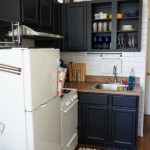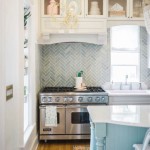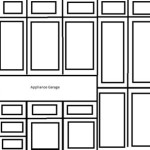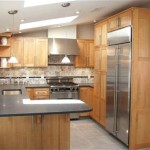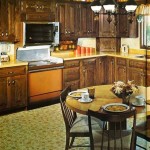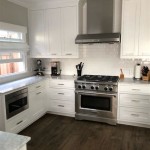Blocking for Kitchen Cabinets: A Comprehensive Guide
Installing kitchen cabinets is a significant undertaking, requiring meticulous planning and execution. One crucial aspect of the process is blocking, a step often overlooked but essential for ensuring the stability and functionality of your cabinetry. Blocking refers to securing wooden supports, typically 2x4s, to the wall studs behind the cabinets. These blocks create a firm foundation for the cabinets, preventing them from sagging or shifting over time. This article delves into the importance of blocking for kitchen cabinets, outlining key considerations, and providing a step-by-step guide for effectively implementing this technique.
Why Blocking is Essential
Blocking for kitchen cabinets serves several critical purposes:
-
Structural Support:
Cabinets, especially those with heavy doors or filled with appliances, exert significant weight on the wall. Blocking distributes this weight evenly, preventing the cabinets from pulling away from the wall or sagging under stress. -
Cabinet Stability:
When properly blocked, cabinets remain securely in place, minimizing movement and providing a consistently level surface. This stability is crucial for ensuring smooth operation of drawers and doors. -
Enhanced Safety:
Blocking prevents cabinets from becoming loose or detaching from the wall, reducing the risk of accidents, particularly in areas with children or pets. -
Improved Aesthetics:
Blocking contributes to a more professional and polished finish, ensuring that cabinets hang straight and flush with the wall.
Determining Blocking Requirements
The specific blocking requirements depend on factors such as cabinet size, weight, and the material of the wall. It's essential to carefully assess these factors to determine the appropriate amount and placement of blocking.
-
Cabinet Size and Weight:
Larger and heavier cabinets demand more robust blocking. For instance, a tall pantry cabinet requires blocking at multiple points along its height. -
Wall Material:
Walls constructed of drywall require more blocking than those made of solid masonry. Drywall provides less support and can be easily punctured by cabinet screws. -
Cabinet Installation Method:
Different installation methods, such as hanging cabinets on cleats or using face-frame construction, necessitate distinct blocking strategies.
Blocking Techniques and Materials
There are various methods for blocking kitchen cabinets, each with its advantages and disadvantages:
Standard Blocking
This commonly used method involves securing 2x4s directly to the wall studs using construction screws.
-
Advantages:
Simple to implement, cost-effective, and provides strong support. -
Disadvantages:
May be challenging in areas with limited access to wall studs, requiring adjustments to cabinet dimensions.
Cleat Blocking
Instead of directly blocking the wall studs, this method utilizes cleats attached to the studs, providing a continuous horizontal support for the cabinets.
-
Advantages:
Allows for easier adjustment of cabinet height, ideal for uneven walls, and eliminates the need to drill directly into studs. -
Disadvantages:
Requires more work to install cleats, may necessitate the use of longer screws to secure cabinets to the cleats.
Other Blocking Options
Alternatives to traditional blocking include:
-
Metal Brackets:
Provide strong support and are easily adjustable. However, they may be more expensive than traditional blocking. -
Cabinet-Specific Blocking Systems:
Some cabinet manufacturers offer proprietary blocking solutions designed to complement their products.
Step-by-Step Blocking Guide
Follow these steps to effectively block for kitchen cabinets:
-
Determine Blocking Requirements:
Assess cabinet size, weight, wall material, and installation method to establish the necessary blocking points and materials. -
Locate Wall Studs:
Use a stud finder to identify the location of studs behind the proposed cabinet locations. Mark their positions on the wall. -
Cut Blocking Material:
Measure and cut 2x4s to the required length for each blocking point. Ensure a snug fit against the wall studs and between the cabinets. -
Secure Blocking to Studs:
Attach the blocking material to the studs using construction screws. Use at least two screws per block, ensuring they penetrate the stud for maximum strength. -
Install Cabinets:
Once blocking is in place, proceed with installing the cabinets according to the manufacturer's instructions. Use screws long enough to reach through the cabinet and into the blocking. -
Level and Secure:
Ensure the cabinets are level and secure by verifying the screws are properly tightened and the cabinets are flush with the wall.
By carefully planning and implementing blocking, you can ensure the stability and longevity of your kitchen cabinets. This often overlooked step contributes significantly to a successful and satisfying kitchen renovation.

Better Cabinet Blocking Fine Homebuilding

Blocking For Kitchen Cabinets Choice Cabinet

9 Blocking Behind Kitchen Cabinets Custom Building Systems

How To Add Stud Wall Cabinet Blocking For Kitchen Installs

Installing Framed Cabinets

Kitchen Cabinet Blocking And Electrical 404 Barndo Barndominium

Kitchen Cabinet Installation Underway Addicted 2 Decorating

No Blocking Allowed Mitre Contracting Inc

The Friendly Survival Guide To Installing Sektion Kitchen Cabinets

5 Things You Ll Only Get With Custom Cabinetry Signature Home Services
Related Posts



